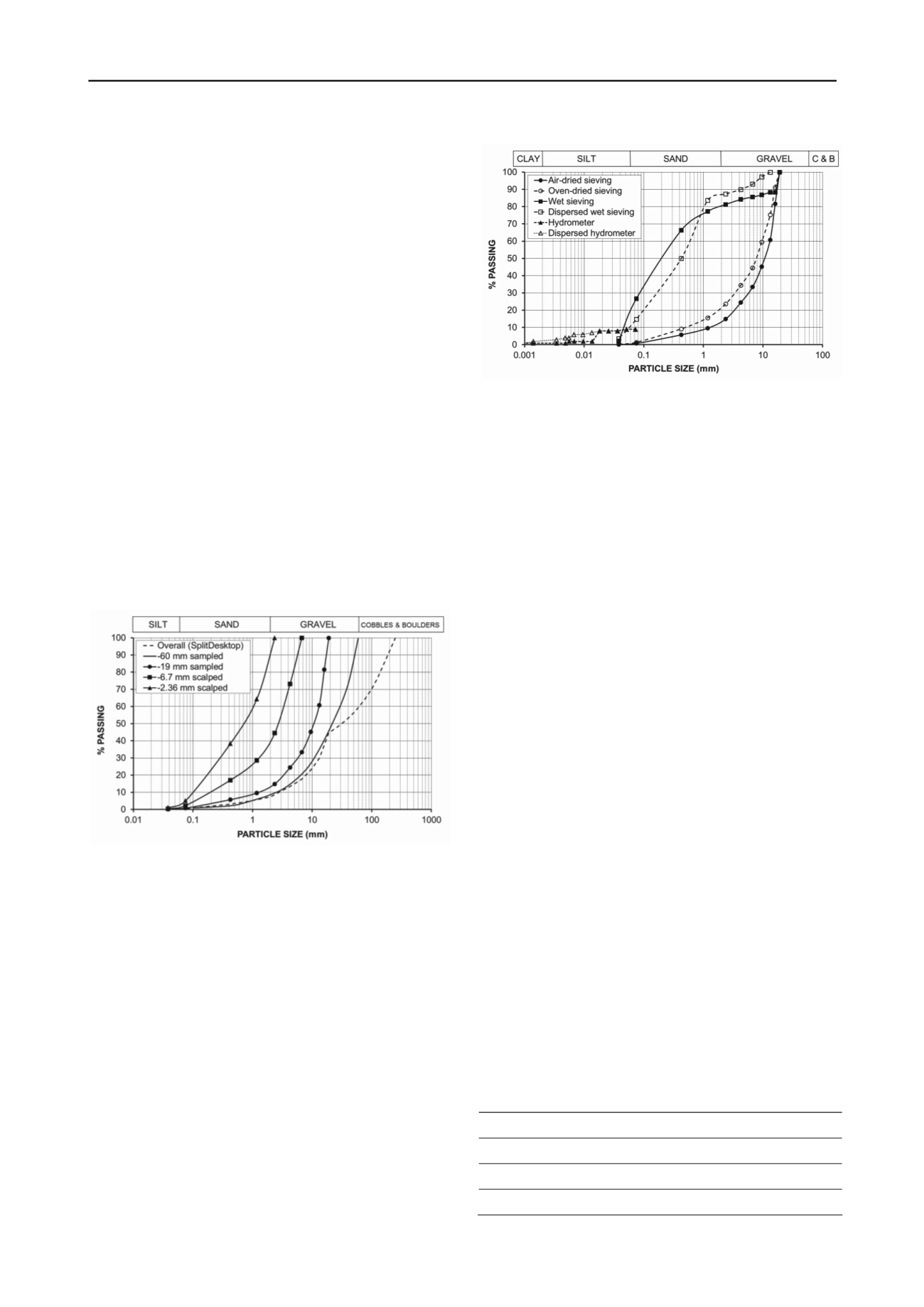
442
Proceedings of the 18
th
International Conference on Soil Mechanics and Geotechnical Engineering, Paris 2013
Proceedings of the 18
th
International Conference on Soil Mechanics and Geotechnical Engineering, Paris 2013
Plasticity). Note that the as-sampled moisture state was drier
than the Plastic limit. In the as-sampled moisture state, the -
2.36 mm scalped sample had a total suction, measured using a
WP4 Dewpoint Potential Meter, of 4,320 kPa. The specific
gravity of the solids, measured using a helium pcynometer, was
2.60.
The electrical conductivity (EC) and pH of a 5 (deionised
water) to 1 (-2.36 mm scalped, dry solids) paste of Jeebropilly
weathered rock were 356 µS/cm and 4.0, respectively. From the
measured EC, corrected to 25
o
C, and the relationship between
EC and osmotic suction (after U.S.D.A. 1954), an as-sampled
osmotic suction of 10 kPa was obtained, and a matric suction of
4,310 kPa was obtained by subtraction from the measured total
suction. The Emerson Class Number of the Jeebropilly
weathered rock was 1, implying that the material slakes and
disperses completely, and had a high potential for breakdown
and erosion.
Mg
2+
is the dominant cation in the Jeebropilly weathered
rock, and its high cation exchange capacity (CEC) of
16 cmol(+)/kg and sodium adsorption ratio (SAR) of 0.76
suggest a relatively high clay content, low permeability, limited
structure, the potential for compaction under trafficking, and the
potential for internal erosion.
The particle size distribution curves obtained from
photographs using SplitDesktop (
-
desktop/) or by dry sieving after air-drying of the -19 mm
scalped Jeebropilly weathered rock are shown in Figure 1,
together with the scalped curves obtained by the removal of the
oversize, for use in the various laboratory tests.
Figure 1. Particle size distribution curves of Jeebropilly weathered rock
overall, and scalped for use in various laboratory tests.
The particle size distribution curves obtained for the -19 mm
scalped Jeebropilly weathered rock by dry sieving after air-
drying or 60
o
C oven-drying, by wet sieving using tap water
without or with dispersant added, and by hydrometer analysis in
deionised water without or with dispersant added, are shown in
Figure 2.
It is clear from Figure 2 that Jeebropilly weathered rock is
extremely prone to breakdown in the presence of water,
dominated by the gravel fraction breaking down to sand-size,
with no appreciable generation of silt and clay fines. The results
of the hydrometer analyses suggest that the fines content is less
than 10% by mass, and that the clay content is negligible.
However, it is likely that the intrinsic particle size does contain
appreciable silt and clay fines, and that these would require
more energy to be released than is applied in the standard test
procedure. The effect of adding dispersant is minor.
Laboratory Standard compaction testing of -19 mm scalped
Jeebropilly weathered rock indicated a low Maximum Dry
Density (MDD) of only 1.52 t/m
3
, at an Optimum (gravimetric)
Moisture Content (OMC) of 19.0%, close to the Plastic Limit of
the material. At the MDD and OMC, the material has a high
porosity of 0.42 and a low degree of saturation of 69%.
Figure 2. Particle size distribution curves of -19 mm scalped Jeebropilly
weathered rock obtained with different pre-treatments and testing
methods.
4 SHEAR STRENGTH
Shear strength testing of loosely-placed, -2.36 mm scalped
Jeebropilly weathered rock, at its as-sampled gravimetric
moisture content of 14.8% (that is, tested “dry”) or tested in a
water bath (that is, tested “wet”), was carried out in a 60 mm
direct shear box. It demonstrated that the shear strength
envelopes obtained were not substantially dependent on the
shearing rate over the range from 0.01 mm/min to 1 mm/min;
implying that drained conditions existed over this range.
On testing dry, the loose-placed dry density of the
Jeebropilly weathered rock averaged 0.908 t/m
3
. This increased
to an average 1.226 t/m
3
after 24-hour compression under a
normal stress of 500 kPa, and to an average 1.370 t/m
3
(75% of
MDD) after shearing. Compression increased the average
degree of saturation from the loose-placed value of 20.7 to
34.4% and 36.9% after shearing, as the average porosity
decreased from 0.650, to 0.528 to 0.510, respectively.
On testing wet, the loose-placed dry density of the
Jeebropilly weathered rock averaged 0.991 t/m
3
. This increased
to an average 1.351 t/m
3
after 24-hour compression under a
normal stress of 150 kPa, and to an average 1.445 t/m
3
(82% of
MDD) after shearing. Compression decreased the average
gravimetric moisture content from the loose-placed value of
70.4 to 35.5% and 34.3% after shearing, as the average porosity
decreased from 0.647, to 0.480 to 0.471, respectively.
The shear strength parameters obtained for -2.36 mm scalped
Jeebropilly weathered rock are summarised in Table 1, in terms
of apparent cohesion and friction angle, and friction angle only
(assuming zero cohesion). These values are in broad agreement
with those recommended for comparable coal mine spoil
materials (Simmons 1995).
Shear strength testing of -2.36 mm scalped Jeebropilly
weathered rock was also carried out in a 300 mm direct shear
box at a shearing rate of 1 mm/min. The shear strengths
obtained from the 60 mm and 300 mm direct shear box testing
at a shearing rate of 1 mm/min are compared in Figure 3. The
results from the smaller shear box cover a far greater range
between dry and wet conditions than those from the 300 mm
shear box, and appear more plausible.
Table 1. Shear strength parameters for Jeebropilly weathered rock.
State
Dry
Wet
Apparent cohesion (kPa)
29
6.0
Apparent friction angle (deg.)
27.2
19.5
Friction only angle (deg.)
35.2
22.0


